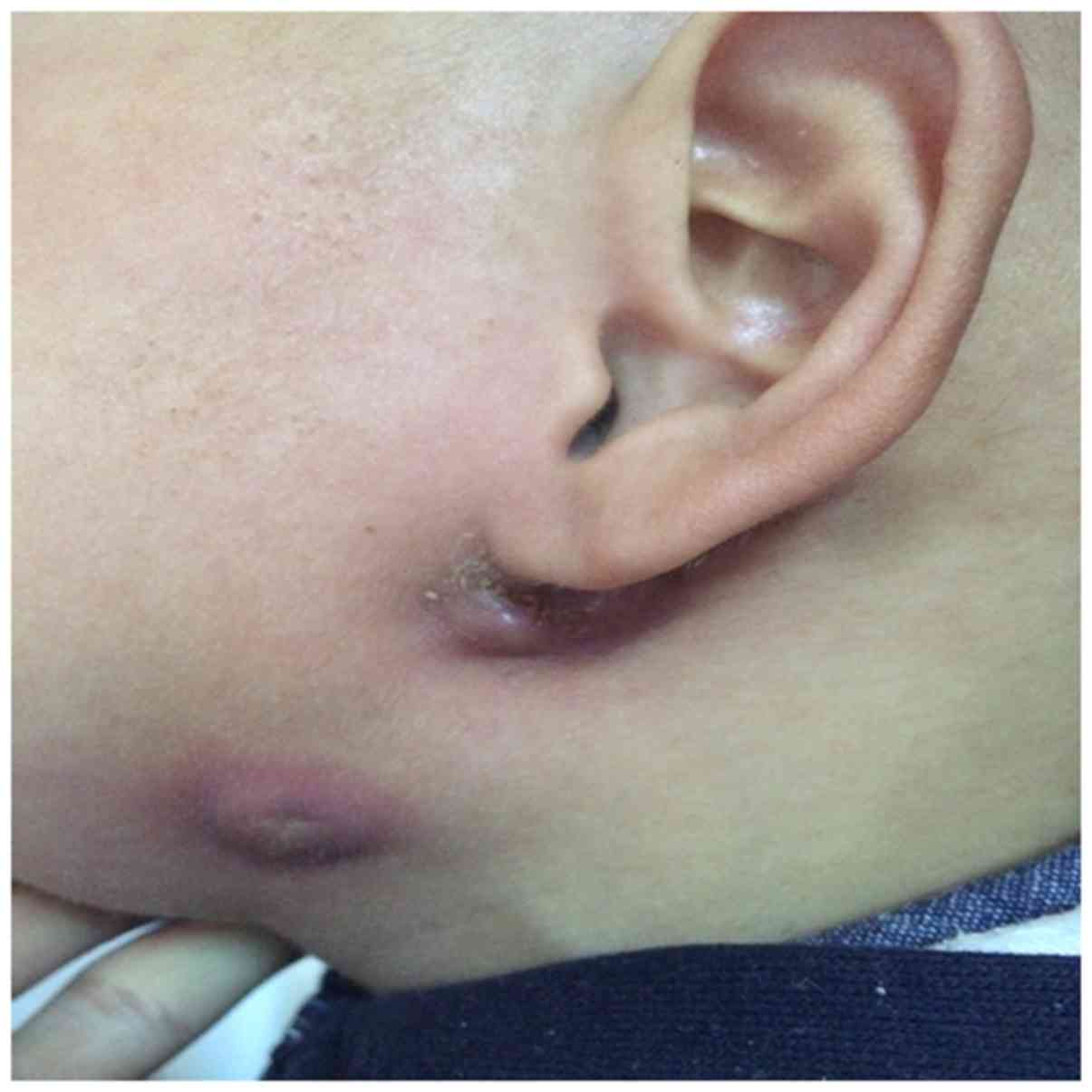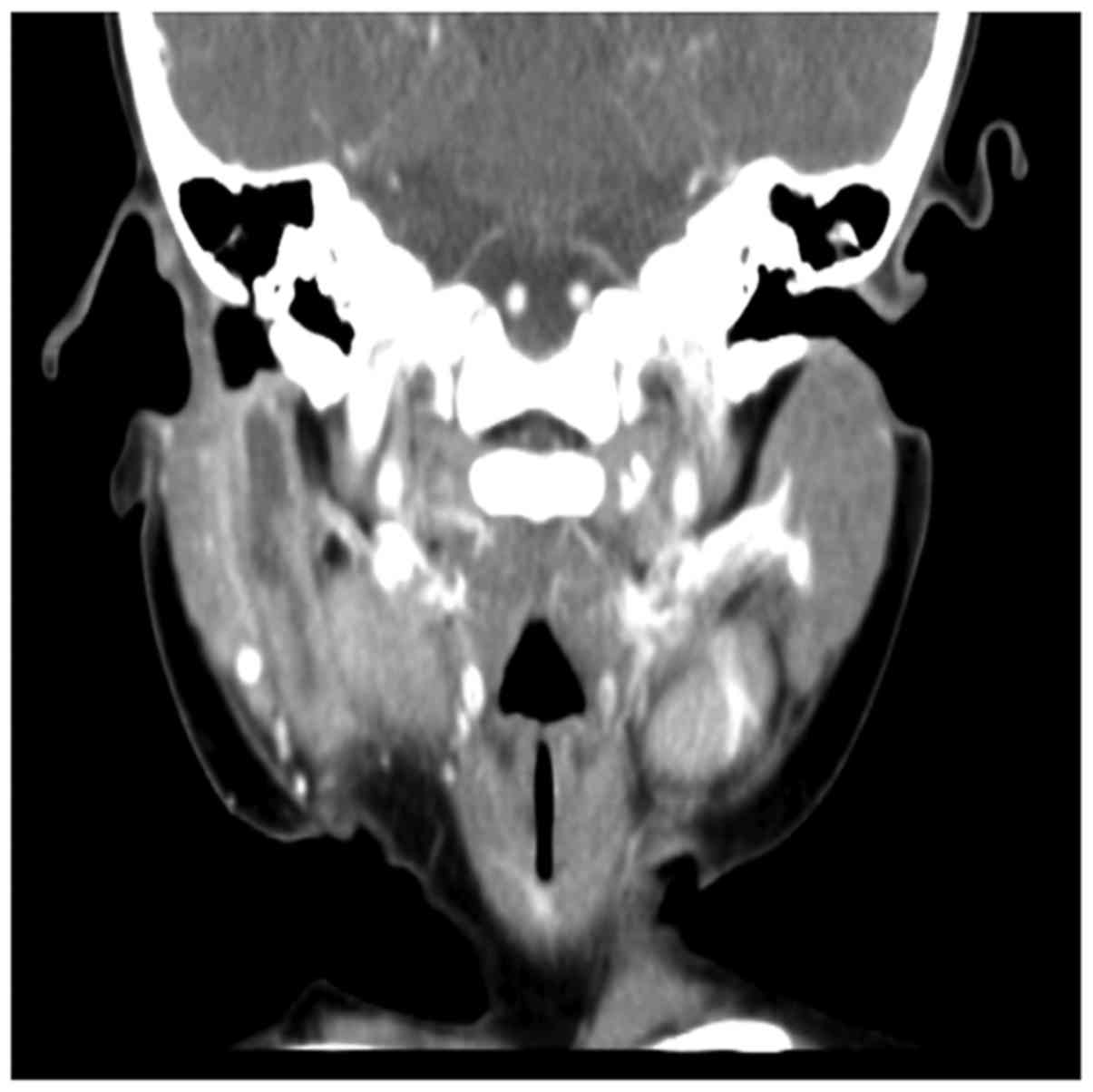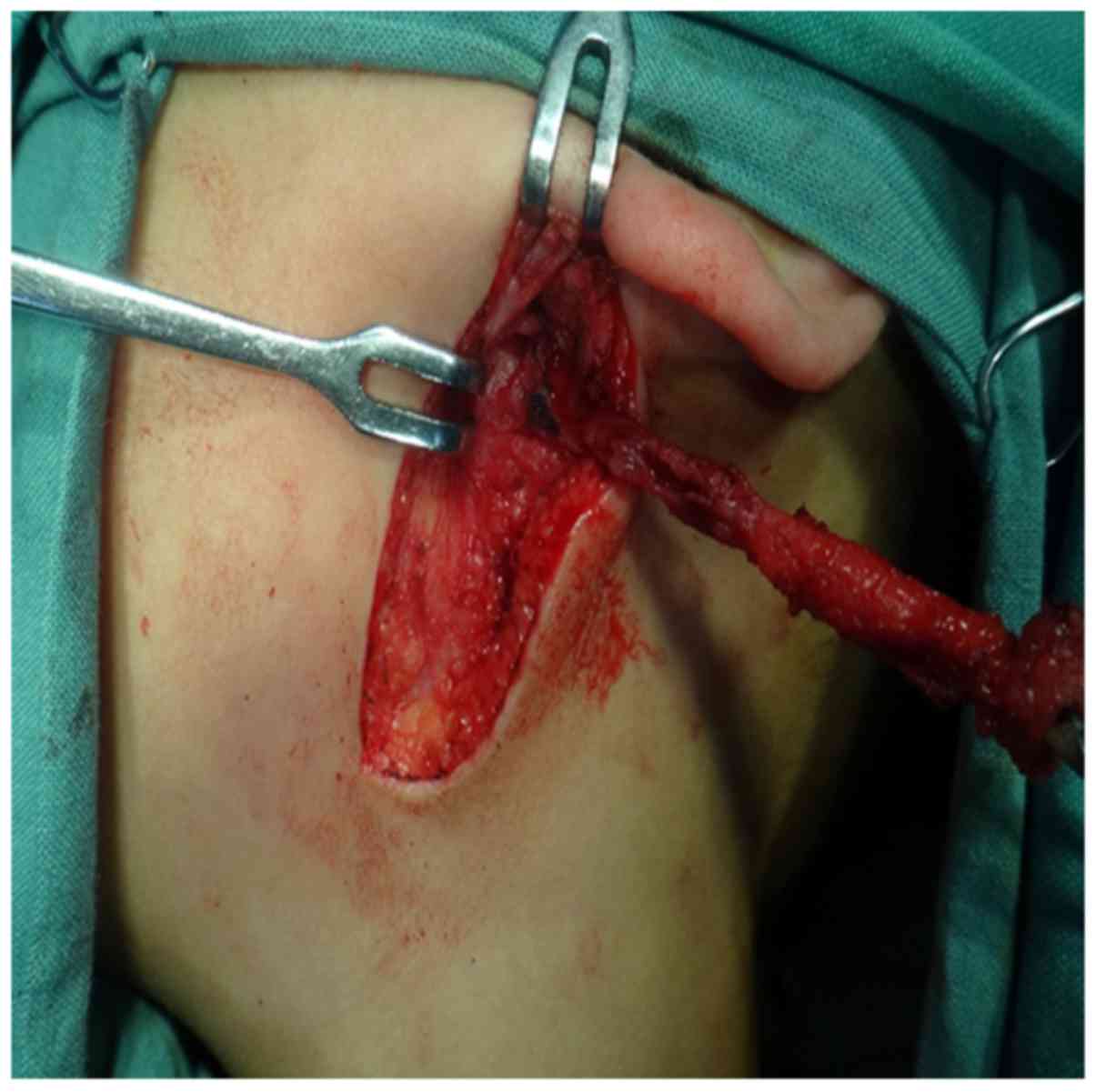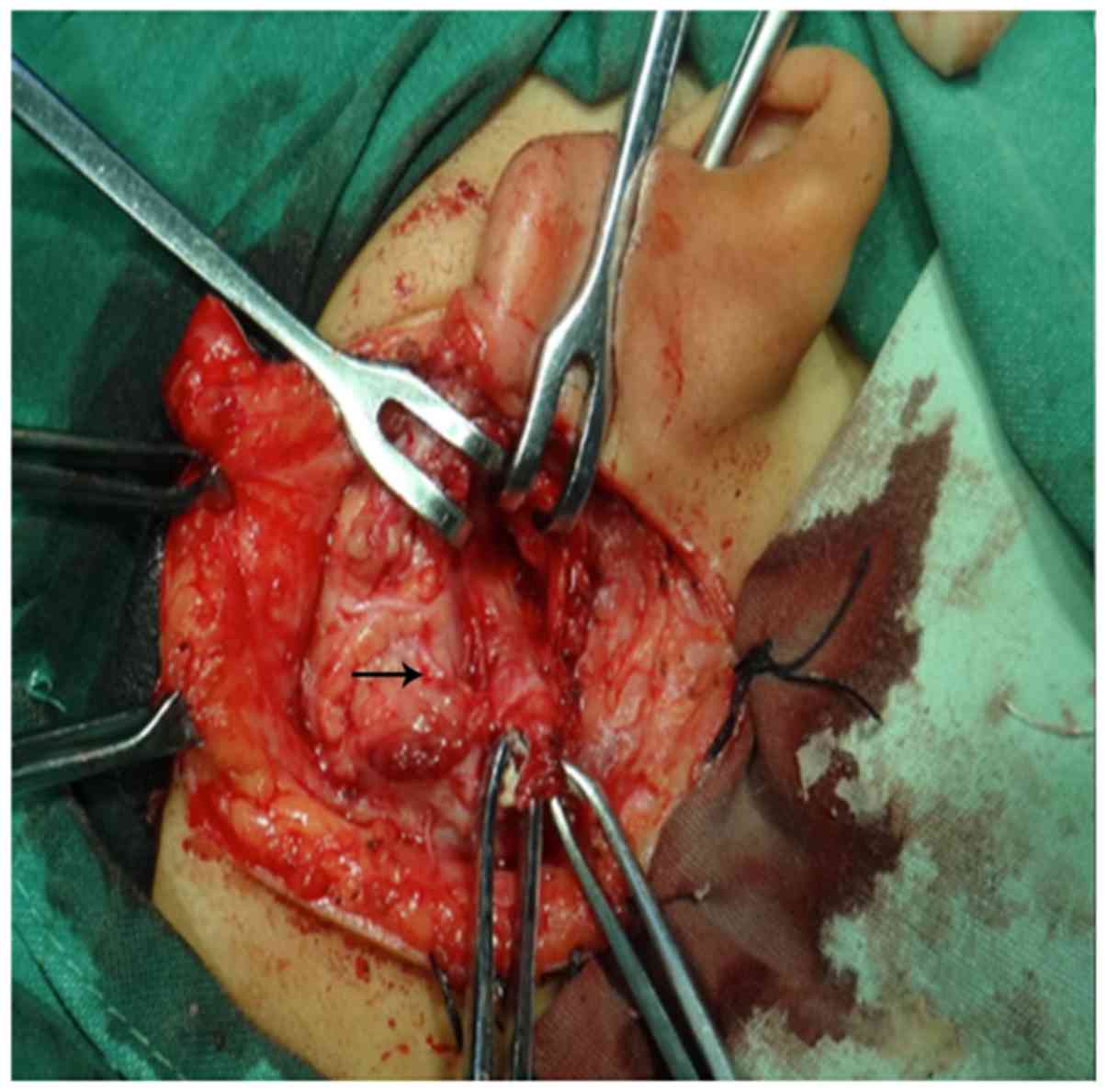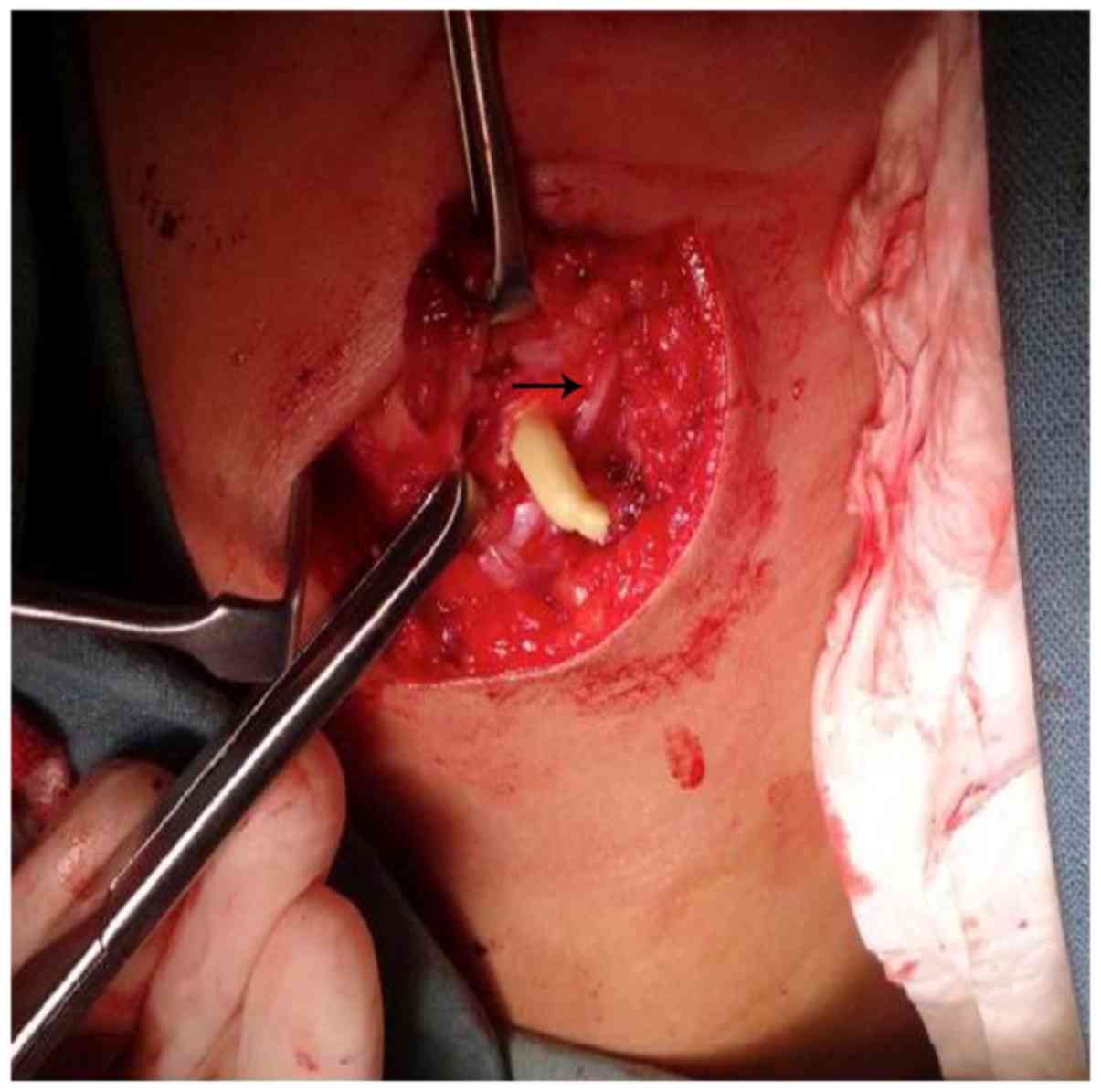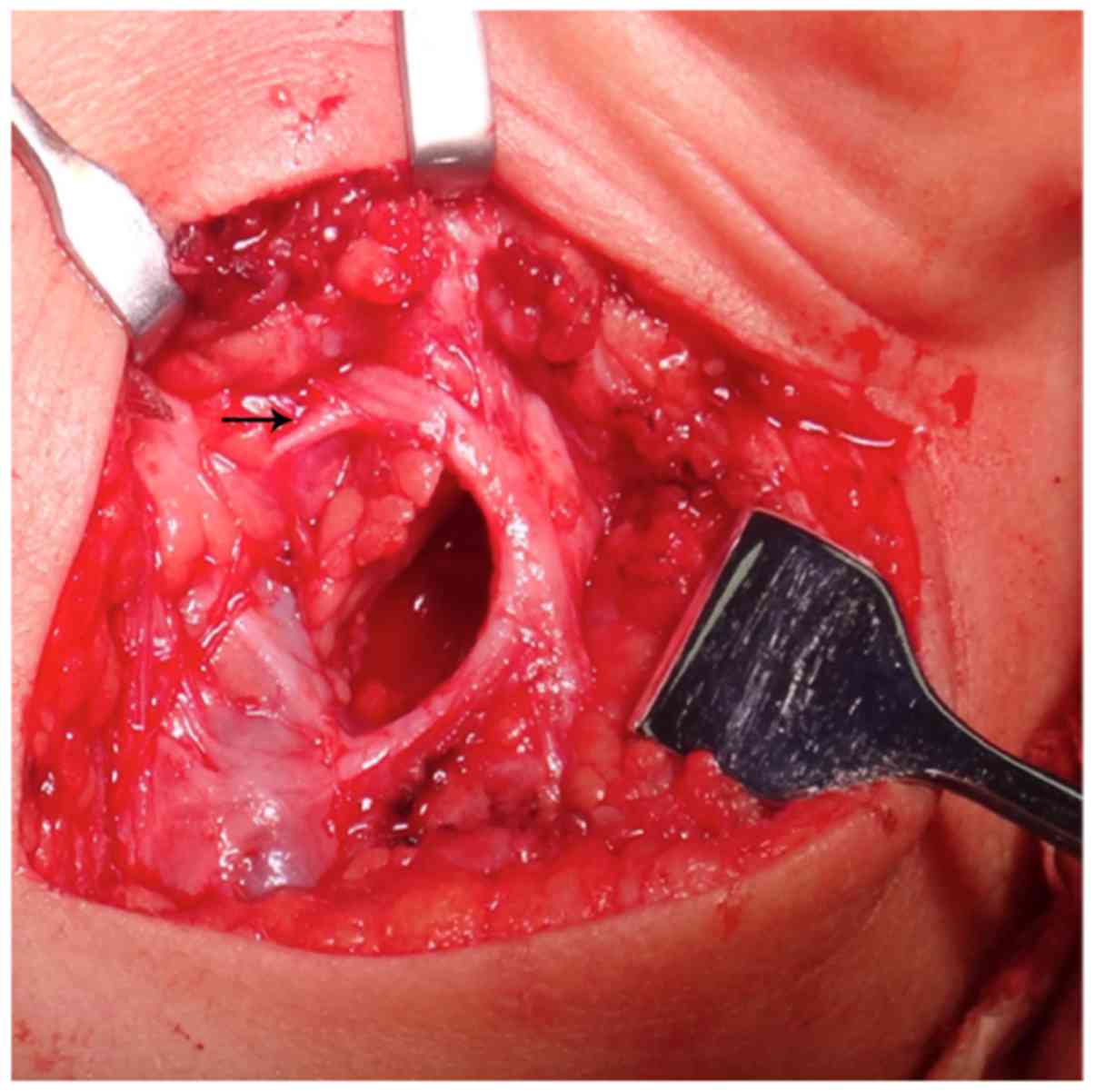First branchial cleft anomalies in children: Experience with 30 cases
- Authors:
- Published online on: May 24, 2017 https://doi.org/10.3892/etm.2017.4511
- Pages: 333-337
-
Copyright: © Li et al. This is an open access article distributed under the terms of Creative Commons Attribution License.
Abstract
Introduction
Congenital branchial cleft anomalies are the second most common lesions in the head and neck in children (1). The term branchial cyst was first mentioned by Ascherson in 1832 (2). First branchial cleft anomalies (FBCA) account for 1 to 8% of all types of anomalies. Four theories have been proposed for the development of FBCA, which include incomplete obliteration of the branchial clefts, persistence of vestiges of the precervical sinus, the thymopharyngeal theory and the cervical lymph node theory (3). The most widely accepted theory is the incomplete obliteration of the branchial clefts during embryogenesis. According to the varying degree of closure, the lesion could present sinus, fistula or cyst. Six pairs of branchial arches appear during the 4th week of human embryological development, and these arches are separated from each other by 5 pharyngeal pouches internally (endoderm) and the 5 branchial clefts (ectoderm) externally. In the embryonic period at seven weeks, the arches fuse and the clefts obliterate. FBCA are due to incomplete fusion of the ventral portion of the first and second arches. During development, the closure time of the cleft is concurrent with the migration of the facial nerve and emergence of the developing parotid gland, which originates from the second branchial arch; thus, FBCA have a close relationship between these structures. As obliteration of the cleft proceeds from ventral to dorsal, lesions occur more often near the ear and parotid gland area than at the hyoid region (4).
FBCA can occur in any part of the external auditory canal (EAC) to the mandibular angle, including the parotid gland area. The complete removal of the lesion is the only way to treat FBCA, and one of the key factors for complete excision is keeping the tract, cyst, and any fistula or scar tissue intact (5–7). Fistulas are often closely associated with the facial nerve, which is prone to damage during the operation, thus causing facial paralysis postoperatively and decreasing the quality of life in children. Therefore, the surgical treatment of FBCA is challenging. This study analyzes all the cases of FBCA operated at Shanghai Children's Hospital (Shanghai, China) during the past 7 years.
Materials and methods
This study was conducted at the Pediatric ENT Department at Shanghai Children's Hospital in China. All children who underwent surgery for first branchial cleft sinus or fistula from June 2009 to June 2016 were included in this study. The data included patient demographics, operative details, histopathological sections and postoperative course. The data revealing the relationship between the facial nerve and the branchial cleft were also analyzed.
Results
The summary of patients was depicted in Table I. Thirty patients (11 male and 19 female) with anomalies of FBCA were diagnosed. The ages ranged from 1 to 13 years (median, 3 years). The lesions were on the right side in 10 cases and on the left in 20. Bilateral lesions were not recorded. Seven cases had no previous intervention, and 23 cases had received a previous intervention. 22 cases had been treated by abscess incision and drainage, 7 cases had received 2 abscess incision and drainage procedures, and 4 cases had received abscess incision and drainage three times. Four cases had a history of surgical resection, and all underwent one surgery. Olsen et al classified the defects as cysts, sinuses, or fistulas in 1980 (8). Three cases were cysts. Fourteen cases involved sinus defects. There were 13 cases with fistulas, which had external and internal openings. In 17 cases, the lesions were only located in the retroauricular groove. In 3 cases, the lesions were only located in the cheek. The lesions of 3 cases were both located in the cheek and the retroauricular groove, and the lesions of 5 cases were only located near the mandibular angle. In 2 cases, the lesions were both located near the mandibular angle and retroauricular groove (Fig. 1). There were two skin openings of the fistula in some cases, which mostly resulted from abscess incision and drainage. One patient had pinna malformation, and one patient had stenosis of the EAC.
All patients were examined by enhanced CT, which showed cystic lesions or soft tissue shadows in the parotid gland parenchyma or in the surrounding area. The relationship between the fistula and EAC was also clear, and 11 patients were diagnosed with FBCA. Ultrasound scans (US) were performed in 10 cases, but only 1 patient was diagnosed with FBCA, so the positive detection of US is low, but US is the preferred method for neck abscess because it is not radioactive or traumatic.
All children underwent branchial fistula or cyst excision under general anesthesia. The fistulas ended in EAC in 13 cases, in the bottom wall of the EAC in 10 cases, in the front wall in 1 case, in the back wall in 2 cases, and in auricle cartilage in 4 cases. The relation of the anomalies to the facial nerve varied. In reviewing the histopathological results and applying the Work classification from 1972, we found 18 cases of type I and 12 cases of type II. The tract ran deep to the facial nerve in 3 cases, superficial to it in 21 cases, and passed between the branches of the nerve in 6 cases. Twenty cases had a close relationship with the parotid gland. The facial nerve was identified in 20 of the 30 patients. The facial nerve was not identified in ten patients, as the tract was superficial to it. There were 2 cases of postoperative temporary facial paralysis (2/30, 6.7%). The symptoms gradually improved after one month; 1 case had permanent facial paralysis (1/30, 3.3%), and 1 case had postoperative recurrence (1/30, 3.3%).
Discussion
FBCA is the most unusual type (8 to 10%) of all branchial cleft deformities and accounts for 17% of all cervical masses in children (9,10). We found 87 cases of branchial cleft deformity from 2009–2016, and the proportion of FBCA was 34.5% (30/87, 34.5%). The number of cases was more than the second branchial fistula (11/87, 12.6%). The annual incidence of FBCA has been reported as 1 per 1,000,000, and they occur more frequently in females (69%) compared with males (31%). The lesions are more likely to occur on the left side (5). We found 19 female cases (19/30, 63.3%) and 11 male cases (11/30, 36.7%). Twenty cases involved the left side (20/30, 66.7%), and 10 cases involved the right side (10/30, 33.3%). Our study's findings were similar to those of previous literature.
According to the anatomic classification, Arnot in 1972 divided FBCA into two types: Type I mainly occurs in early or middle adult life as a defect in the parotid region, and type II defects mainly occur during childhood and appear in the anterior cervical region (11). The Arnot classification in FBCA of our cases were depicted in Table II. Our department found 7 cases of type II, and we found that type II FBCA involved the EAC. The route of the tract was longer than that of type I defects, and 3 lesions were located deep to the facial nerve, while 4 lesions passed between the branches of the facial nerve. Therefore, type II had a close relationship with the facial nerve, and the facial nerve should be identified during operations. There were 23 cases of type II according to the Arnot classification. Twenty-one cases were superficial to the facial nerve, and 2 cases passed between the branches of the facial nerve, so type I usually did not require identifying the facial nerve (10/23, 43.5%). The surgery for type II is generally more difficult than that for type I.
Work classified FBCA into two types in 1972 based on clinical features and histopathology (12). Type I anomalies are purely ectodermal and often present a cystic mass. Pathology shows squamous epithelium but no cartilage or skin adnexa. Type II anomalies are ectodermal and esodermal and involve a cyst, sinus or fistula tract. Histology shows squamous epithelium with cartilage or skin adnexa. In 3 cases, the cystic mass was type I. There was no difference between the sinus or fistula tract forms.
Almost all FBCA occur in the Pochet's triangle area, which consists of the EAC, the hyoid body and the mandibular angle, particularly in the retroauricular groove or parotid region. The lesions of the triangle area usually present repeatedly with swelling, pain, and purulent discharge of the skin fistula. Preoperative enhancement CT examination can help define the size of the lesion and anatomic relationship to important surrounding structures, such as the facial nerve, EAC and parotid gland (Fig. 2), this information can be helpful for determining the surgical approach, and ultrasonic examination, as the preferred therapy for head and neck tumors, can display the mass as substantive or cystic. FBCA is characterized by low-echo area or cystic appearance.
FBCA is easily misdiagnosed, and Triglia et al reported a delay of 3.5 years between the onset of the first clinical symptom and when adequate treatment is received, with almost 50% of patients not receiving successful treatment (13). Shinn et al noted that more than half of the children had received an incision and drainage before the surgical removal of the fistula, and more than a quarter of the patients had a history of surgery (14). Of our cases, 22 (22/30, 73.3%) patients had a history of incision and drainage. Only 4 cases received surgery (4/30, 13.3%), so the inflammation phase of the FBCA was difficult to diagnose, and most children underwent abscess incision and drainage because of swelling and pain. We generally conduct surgery to remove a fistula when inflammation is controlled for one month. Guo and Guo (15) recommended that the most appropriate timing for surgery on FBCA is after 4 years of age because surgery will be easier after complete maturation of the facial nerve, with a decreased risk in damaging the facial nerve. However, the ages in our cases ranged from 1 to 13 years, and the median age was 3 years. Early diagnosis and surgical treatment is suggested in our experience. The risk of facial palsy during the surgical removal of FBCA is higher if a patient has a history of recurrent infections and inadequate treatment (incision, drainage or incomplete excision) that may make the tract have adhesions with the facial nerve, so immediate surgery once the diagnosis has been confirmed can minimize the risk of scarring.
The course of the tract varies and has different relationships with the facial nerve. We can divide these variations into 3 types: superficial, deep to the facial nerve, or between the branches of the nerve. The surgical approaches differ according to the various types. A review of 83 patients with FBCA analyzed the relationship between the facial nerve and tract, and 47 cases were superficial, 25 cases were deep to the facial nerve, and 11 cases were between the branches of the nerve (5). In our patients, the lesions of 21 cases lay superficial to the facial nerve, which occurs most often, and we usually did not need to identify the nerve during surgery (10/21, 47.6%). Instead, we tracked the tract from Pochet's triangle to the EAC (Fig. 3). Parts of the lesion had superficial adhesions with the parotid (11/21, 52.4%), so we needed to partially excise the parotid and identify the facial nerve during the operation. The lesions of 3 cases were deep to the facial nerve, which is the rarest case, and we found that these tracts were thick. It was easy to identify these cases as belonging to the Work II type. Guo and Guo reported that this type of tract needed to receive a superficial parotidectomy and exposure of the facial nerve and its branches to ensure safe recovery (15). However, the lesions of 3 cases were located in the mandibular angle, and a spindle incision for the lesion was made. We separated the fistula tract in the direction of the EAC. The tract was tracked from the gap, which is surrounded by the deep lobe of parotid gland, the bottom of the EAC and sternocleidomastoid, this method avoided excessive resection of the parotid gland, and we did not need to completely identify the facial nerve to reduce the risk of facial palsy (Fig. 4). The lesions of 6 cases were between the branches of the nerve (Fig. 5). The surgery for this type was the most difficult, and the trunk and each branch of the facial nerve should be identified (Fig. 6), a superficial parotidectomy approach with a wide exposure was performed to preserve facial nerve. For the cases who had received the previous intervention, such as abscess incision and surgical resection, the scar tissue formation around the fistula could result in the displacement of facial nerve trunk. but the position of marginal mandibular branches was relatively stable, we could reverse the anatomy of facial nerve trunk through the anatomy of marginal mandibular branches in the first place. For the cases who had no previous intervention, the anatomy of the facial nerve trunk was firstly considered. In addition, as the tract adheres with the facial nerve, the surgeon does not have a solid foundation to identify the facial nerve, and it is easy to relapse for the residual fistula or injure the facial nerve, which influences the patient's quality of life after surgery.
D'Souza et al reported 87 cases of FBCA in which they identified the facial nerve, 18 cases of patients with temporary facial paralysis (18/87, 20.7%), 1 case with permanent facial paralysis (1/87, 1.1%), and 12 cases with recurrence (12/87, 13.8%) (5). Triglia et al reported 39 patients received surgery for FBCA, of which 5 cases had temporary facial paralysis (5/39, 12.8%), 1 case had permanent facial paralysis (1/39, 2.6%), and postoperative recurrence occurred in 3 patients who required reoperation (3/39, 7.7%) (13). In our patients, 2 cases had postoperative temporary facial paralysis (2/30, 6.7%), 1 case had permanent facial paralysis (1/30, 3.3%), and 1 cases had postoperative recurrence (1/30, 3.3%). This result occurred because this patient had a history of incision and drainage due to infection. The fistula with scar adhesion was very obvious during the operation. We could not find and remove the fistula completely, so complete removal of the tract and protection of the facial nerve was challenging.
Some authors suggest injecting methylene blue to display the tract of the fistula (15,16). We do not use this approach because the dye may leak into neighboring tissues and obscure the surgical area, even if it is impossible to identify the facial nerve. The cyst type of FBCA with no skin fistula cannot be injected with methylene blue. In some patients with repeated abscess incision and drainage procedures, the fistula may be closed because of scar adhesion, and methylene blue also cannot be injected.
As we intraoperatively track the tract of FBCA to the EAC, the part of the EAC wall that adheres to the fistula tract must be removed. Fourteen cases in our study had a burst of the EAC during the operation, and if resection is too great, it can cause hyperplasia of granulation tissue in the EAC wall, even causing stenosis of the EAC. If resection is too slight, the missing residual tract and epithelial tissue may cause recurrence. We considered that filling the EAC with iodoform gauze for two weeks after the operation can prevent growth of granulation tissue and stenosis of the EAC. For patients who have growth of granulation tissue, we can shave the granulation tissue and use hormone ointment to daub the EAC, which is effective.
FBCA is rare in the clinical setting and is easily misdiagnosed. Clinical manifestations include repeated swelling or discharge of the skin fistula in Pochet's triangle area. Complete excision of the tract is the only way to manage FBCA, but the course of the tract varies and has different relationships with the facial nerve (3 types: Superficial, deep to the facial nerve, between the branches of the nerve). Therefore, surgical approaches differ according to the various types, and careful preoperative planning and protection of the facial nerve during resection of the tract are essential.
References
|
Bajaj Y, Ifeacho S, Tweedie D, Jephson CG, Albert DM, Cochrane LA, Wyatt ME, Jonas N and Hartley BE: Branchial anomalies in children. Int J Pediatr Otorhinolaryngol. 75:1020–1023. 2011. View Article : Google Scholar : PubMed/NCBI | |
|
Mitroi M, Dumitrescu D, Simionescu C, Popescu C, Mogoantă C, Cioroianu L, Surlin C, Căpitănescu A and Georgescu M: Management of second branchial cleft anomalies. Rom J Morphol Embryol. 49:69–74. 2008.PubMed/NCBI | |
|
Chandler RJ and Mitchell B: Branchial cleft cysts, sinuses, and fistulas. Otolaryngol Clin North Am. 14:175–186. 1981.PubMed/NCBI | |
|
Benson MT, Dalen K, Mancuso AA, Kerr HH, Cacciarelli AA and Mafee MF: Congenital anomalies of the branchial apparatus: Embryology and pathologic anatomy. Radiographics. 12:943–960. 1992. View Article : Google Scholar : PubMed/NCBI | |
|
D'Souza AR, Uppal HS, De R and Zeitoun H: Updating concepts of first branchial cleft defects: A literature review. Int J Pediatr Otorhinolaryngol. 62:103–109. 2002. View Article : Google Scholar : PubMed/NCBI | |
|
Rattan KN, Rattan S, Parihar D, Gulia JS and Yadav SP: Second branchial cleft fistula: Is fistulogram necessary for complete excision. Int J Pediatr Otorhinolaryngol. 70:1027–1030. 2006. View Article : Google Scholar : PubMed/NCBI | |
|
Quintanilla-Dieck L, Virgin F, Wootten C, Goudy S and Penn E Jr: Surgical approaches to first branchial cleft anomaly excision: A case series. Case Rep Otolaryngol. 2016:39029742016.PubMed/NCBI | |
|
Olsen KD, Maragos NE and Weiland LH: First branchial cleft anomalies. Laryngoscope. 90:423–436. 1980. View Article : Google Scholar : PubMed/NCBI | |
|
Tham YS and Low WK: First branchial cleft anomalies have relevance in otology and more. Ann Acad Med Singapore. 34:335–338. 2005.PubMed/NCBI | |
|
Ford GR, Balakrishnan A, Evans JN and Bailey CM: Branchial cleft and pouch anomalies. J Laryngol Otol. 106:137–143. 1992. View Article : Google Scholar : PubMed/NCBI | |
|
Arnot RS: Defects of the first branchial cleft. S Afr J Surg. 9:93–98. 1971.PubMed/NCBI | |
|
Work WP: Newer concepts of first branchial cleft defects. Laryngoscope. 82:1581–1593. 1972. View Article : Google Scholar : PubMed/NCBI | |
|
Triglia JM, Nicollas R, Ducroz V, Koltai PJ and Garabedian EN: First branchial cleft anomalies: A study of 39 cases and a review of the literature. Arch Otolaryngol Head Neck Surg. 124:291–295. 1998. View Article : Google Scholar : PubMed/NCBI | |
|
Shinn JR, Purcell PL, Horn DL, Sie KC and Manning SC: First branchial cleft anomalies: Otologic manifestations and treatment outcomes. Otolaryngol Head Neck Surg. 152:506–512. 2015. View Article : Google Scholar : PubMed/NCBI | |
|
Guo YX and Guo CB: Relation between a first branchial cleft anomaly and the facial nerve. Br J Oral Maxillofac Surg. 50:259–263. 2012. View Article : Google Scholar : PubMed/NCBI | |
|
Piccioni M, Bottazzoli M, Nassif N, Stefini S and Nicolai P: Intraoperative use of fibrin glue dyed with methylene blue in surgery for branchial cleft anomalies. Laryngoscope. 126:2147–2150. 2016. View Article : Google Scholar : PubMed/NCBI |



